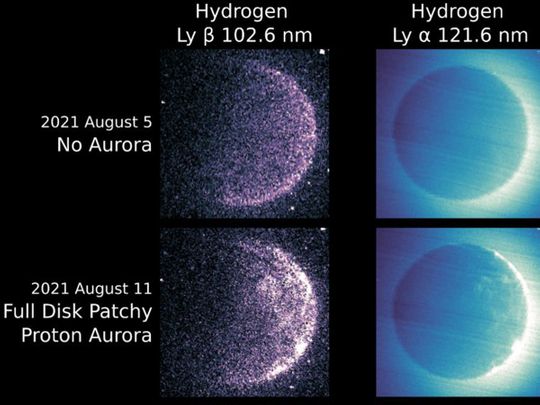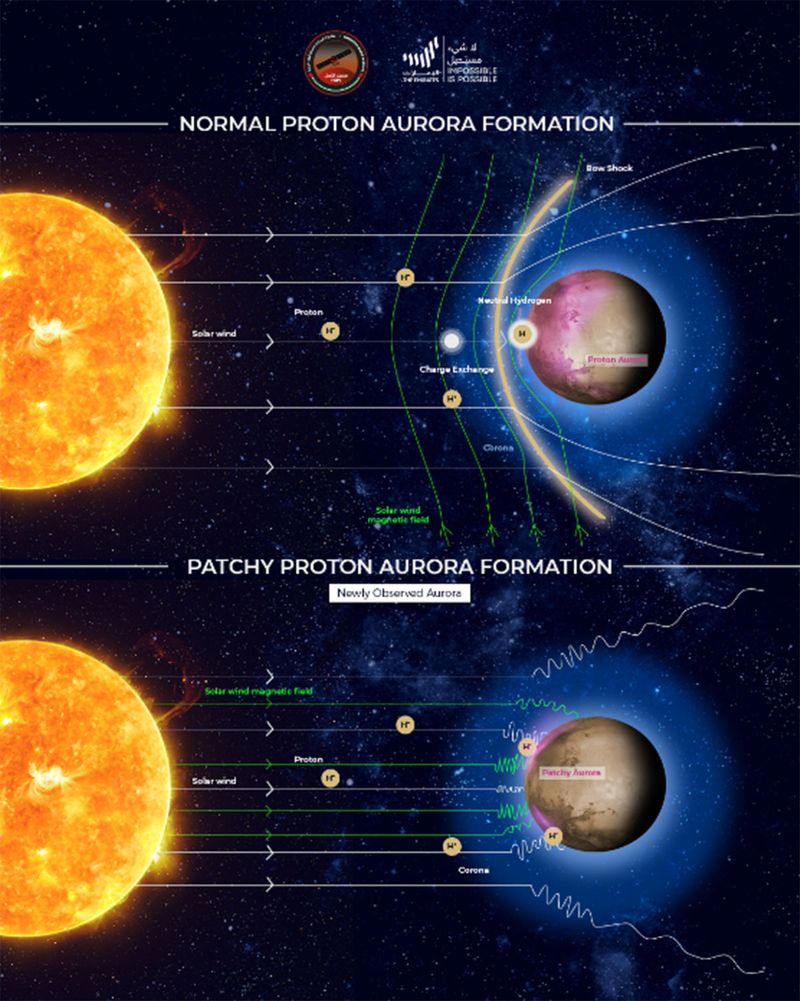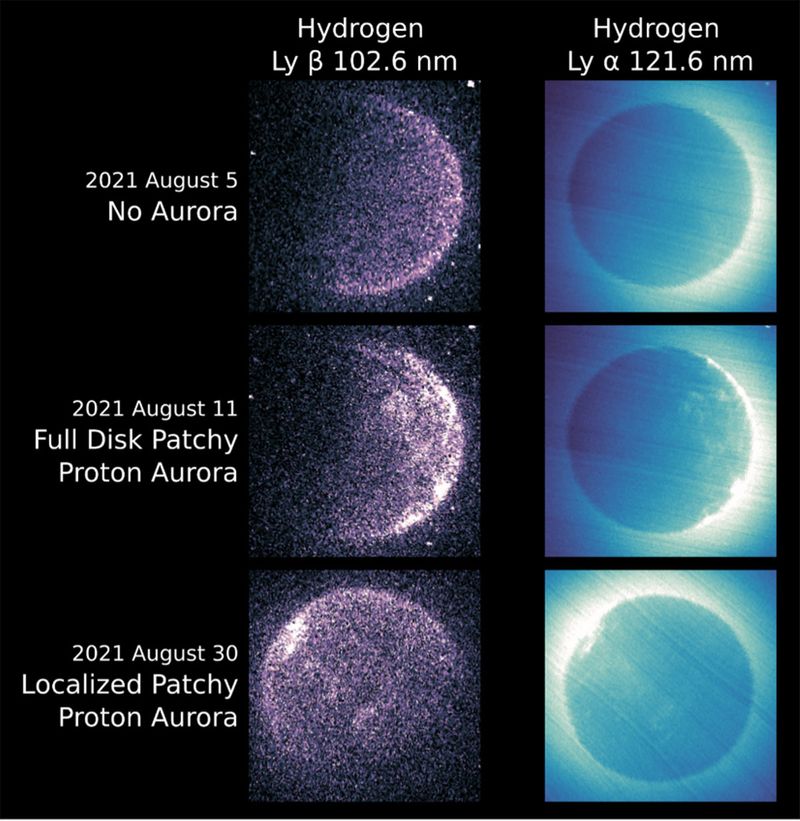Look: UAE’s Hope Probe discovers new ‘patchy’ Mars proton aurora

Image Credit: EMM
Dubai: A new type of proton aurora around Mars has been observed by the Emirates Mars Mission (EMM), in collaboration with US National Aeronautics and Space Administration (NASA), the UAE Space Agency announced on Wednesday.
A proton aurora can help scientists track water loss from Mars’ atmosphere. “The spatially variable ‘patchy’ proton aurora potentially triggers new insights into unexpected behaviours in the Martian atmosphere,” UAE Space Agency said in a statement.
“The EMM team has worked together with NASA’s MAVEN (Mars Atmosphere and Volatile EvolutioN) mission to fully characterise these observations. The combination of EMM’s unprecedented global aurora images with MAVEN’s simultaneous local plasma observations opens up new avenues for understanding the drivers of Mars’ enigmatic aurora.”

Image Credit: EMM
Phenomena uncovered
Hessa Al Matroushi, EMM’s Science Lead, said: “Our discovery of these patchy proton aurora adds a new kind of event to the long list of those currently studied by EMM and challenges our existing views of how the proton aurora on Mars’ dayside are formed.
“The EMM Hope Probe has so far uncovered many unexpected phenomena that extend our understanding of Mars’ atmospheric and magnetospheric dynamics. These new observations, combined with MAVEN data, have lifted the lid on entirely new possibilities for scientific research,” she added.
EMM uncovered the dayside aurora while MAVEN measured local space weather conditions. A data sharing agreement between EMM and MAVEN has enabled analysis of the new EMM images using plasma observations made by MAVEN, which has been characterising the Mars ionosphere and magnetosphere since 2014. MAVEN carries a full suite of plasma instruments, including a magnetometer and two ion electrostatic analysers that measured the Martian plasma and fields environment during EMM’s observations of patchy proton aurora events.
How it looks like
According to the UAE Space Agency, the new patchy type of proton aurora is formed when the solar wind directly impacts Mars’ dayside upper atmosphere and emits ultraviolet light as it slows down. It was discovered in snapshots of the dayside disk obtained by Hope Probe’s Emirates Mars Ultraviolet Spectrometer (EMUS), which observes the planet’s upper atmosphere and exosphere, scanning for variability in atmospheric composition and atmospheric escape to space.
The aurora manifests as bright regions scattered across the dayside of the planet in two ultraviolet wavelengths associated with the Hydrogen atom, Lyman beta at 102.6 nm and
Lyman alpha at 121.6 nm. Under normal conditions, the dayside disk of the planet at these wavelengths is uniform, and the planetary brightness results from Hydrogen atoms scattering sunlight. When the aurora occurs, small regions of the planet become much brighter at these wavelengths, signifying intense localised energy deposition in the atmosphere.
“We’ve seen emissions at these wavelengths before, thanks to proton aurora studies by NASA’s MAVEN mission, but these EMM EMUS images represent the first time we’ve had a global view of spatial variability in proton aurora at Mars, and the first time we’ve been able to unambiguously observe this patchy structure,” said Mike Chaffin, EMM science team member and lead author of a newly submitted paper on the proton aurora.
“We know that these wavelengths are only emitted by the hydrogen atom, which tells us that super energetic Hydrogen atoms must be present in the atmosphere in order to produce the auroral emission,” he added.
MAVEN Principal Investigator Shannon Curry further explained: “Multi-vantage point measurements of the Martian atmosphere tell us about the real time response of the atmosphere to the Sun. These types of simultaneous observations probe the fundamental physics of atmospheric dynamics and evolution.”

Image Credit: EMM
Produced by plasma turbulence
A type of Martian aurora first identified by NASA’s MAVEN spacecraft in 2016 is actually the most common form of aurora occurring on the Red Planet. But most of these previous observations show uniform auroral emission across the dayside of the planet.
By contrast, the EMUS observations are able to unambiguously reveal small-scale spatial structure. Scientists from both teams now believe the patchy aurora can only be produced by plasma turbulence in the space surrounding Mars.
Chaffin noted: “Because of the size scales involved in the solar wind and extended hydrogen atmosphere of Mars, there’s no way the standard proton aurora formation mechanism could produce the aurora we’re observing with EMUS.”
“In the August 11 (2022) observations the aurora is so widespread and so disorganised that the plasma environment around Mars must have been truly disturbed. Thanks to MAVEN measurements of the Mars plasma environment simultaneous with the aurora, we can confidently say that the solar wind is directly impacting the upper atmosphere wherever we’re seeing auroral emission. What we’re seeing is essentially a map of where the solar wind is raining down onto the planet,” he added.
Multiple observations
According to EMM, Hope Probe has observed patchy aurora multiple times over the course of its mission so far, and the shape of the aurora is not always the same. On August 30, 2021 for example, the patchy proton aurora was confined to a much smaller portion of the disk than on August 11 (this year), suggesting a different mechanism may be at work. Plasma turbulence at Mars can occur under a variety of conditions, and different shapes of patchy proton aurora may reveal different plasma conditions.
“As of June 2022, Mars is about a month away from the peak of its Southern Summer, when proton aurora are known to be at their most active. Whether we’ll see anything as spectacular as what we’ve already got is anyone’s guess, but I’m hopeful. Hope continues to far exceed our expectations for scientific discovery, and I can’t wait to see what we learn next,” noted Chaffin.


